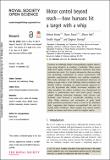Motor control beyond reach—how humans hit a target with a whip
Author(s)
Krotov, Aleksei; Russo, Marta; Nah, Moses; Hogan, Neville; Sternad, Dagmar
Downloadkrotov-et-al-2022-motor-control-beyond-reach-how-humans-hit-a-target-with-a-whip.pdf (1.446Mb)
Publisher with Creative Commons License
Publisher with Creative Commons License
Creative Commons Attribution
Terms of use
Metadata
Show full item recordAbstract
Humans are strikingly adept at manipulating complex objects, from tying shoelaces to cracking a bullwhip. These motor skills have highly nonlinear interactive dynamics that defy reduction into parts. Yet, despite advances in data recording and processing, experiments in motor neuroscience still prioritize experimental reduction over realistic complexity. This study embraced the fully unconstrained behaviour of hitting a target with a 1.6-m bullwhip, both in rhythmic and discrete fashion. Adopting an object-centered approach to test the hypothesis that skilled movement simplifies the whip dynamics, the whip's evolution was characterized in relation to performance error and hand speed. Despite widely differing individual strategies, both discrete and rhythmic styles featured a cascade-like unfolding of the whip. Whip extension and orientation at peak hand speed predicted performance error, at least in the rhythmic style, suggesting that humans accomplished the task by setting initial conditions. These insights may inform further studies on human and robot control of complex objects.
Date issued
2022-10Department
Massachusetts Institute of Technology. Department of Mechanical Engineering; Massachusetts Institute of Technology. Department of Brain and Cognitive SciencesJournal
Royal Society Open Science
Publisher
The Royal Society
Citation
Krotov A, Russo M, Nah M,Hogan N, Sternad D. 2022 Motor control beyond reach—how humans hit a target with a whip.R. Soc. Open Sci.9: 220581.
Version: Final published version
ISSN
2054-5703
Keywords
Multidisciplinary